|
 |
|
|
|
|
4th Day (Wednesday, June 28)
Free Plan |
|
|
It probably rained at night. And now unstable. Seems to be such a weather
today.
Both of our couple had breakfast of only store-bought yogurt in the room
and talked to each other, "Let's eat something when feeling hungry."
Free plan today, so left the hotel by ourselves at 9:00.
Yasaka Shrine is not too far on foot. The roads are in a checkerboard pattern,
so it is easy to judge distance and time.
Walked along Kawaramachi Street down until Shijo Avenue, then turned left
and after a while we saw Minamiza Theater of kabuki in a dignified manner.
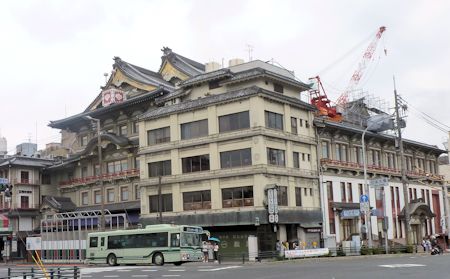
Passing it, Yasaka Shrine appeared right in front.
|
| - - - - - - - - - - |
| Yasaka Shrine |
|
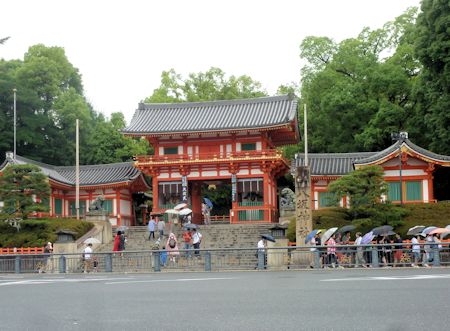 |
|
Yasaka-jinja (jinja means shrine) respects Susano-no-mikoto, Kushinadahime-no-mikoto,
and Yahashira-no-mikogami.
Susano-no-mikoto is a great god in Japanese mythology, known for his defeat
of Yamata-no-orochi (a large serpent with eight heads; a symbol of many
disasters) for the redemption of Kushinadahime-no-mikoto, and produced
the ground great-discernment on the earth.
According to the legend of the shrine, its history may go back as far as
150 years before the Heian era, AC 656 (the second year of the reign of
Emperor Seimei). Along with the development of the capital, adoration to
the shrine spread widely all over Japan. Today, approximately 3,000 satellite
shrines exist in various parts of Japan.
The name of the shrine was changed to Yasaka-jinja when shrines and Buddhist
temples were separated at the time of the Meiji Restoration. The shrine
was originally called the "Gion-sha" or "Kansin-in"
for a long time.
(Yasaka Shrine's website)
|
|
|
|
We went up the stone-steps and passed through West Tower Gate.
Eki Shrine (the god of pestilence enshried) and Ota-Shirahige Shrine are
located around the place thickly covered with camphor and chinquapin trees.
We passed by there and walked on the stone-paved road to reach Main Hall
in the precincts, which was rebuilt in Sho-o 2 (1654).
This shrine is very famous for the Gion Festival. The odd-looking main
hall is in an architectual style of "Gion-zukuri".
The 15 other temple buildings in addition to the main hall are located
in the precincts. I passed by, thinking each of them should have its own
role as a matter of fact.
We stayed there for more than one hour, but were never bored.
|
|
|
Yasaka Shrine, Other Pictures
|
| - - - - - - - - - - |
| Kodaiji Temple |
|
Kodaiji Temple, formally known as Kodaijusho-zenji Temple, is located in
the Higashiyama mountains of eastern Kyoto just south of Yasaka Shrine.
It was established in 1605 by the noble woman Kita-no-Mandokoro in memory
of her late husband, Toyotomi Hideyoshi (1536-98). Kodaiji Temple's construction
was extensively financed by Tokugawa Ieyasu, Hideyoshi's chief vassal and
later Shogun of Japan, and the result was a temple renowned for its beautiful
design and exquisite craftmanship.
In 1624 Sanko Joeki, Abbot of Kenninji Temple, was appointed as a founding
priest, and Kodaiji temple has remained one of Kenninji Temple's largest
and most important sub-temples ever since.
Kodaiji Temple was ravaged by a series of fires after 1789, and all the survivals of its original buildings are only the Otama-ya, Kaisanndo, Kangetsu-dai, Kasa-tei, and Shigure-tei, etc. Fortunately these remain in an excellent state of preservation, and have all been designated "Importnt Cultural Properties" by the Japanese Government.
Kita-no-Mandokoro (known more familiarly as "Nene") was awarded
the highest rank of nobility by Emperor Goyozei in 1588, and in 1603 was
accorded the honorary name Kodai-in.
Following the custom among noble ladies of her time, she became a Buddhist
nun after the death of her husband and adopted the religious name Kogetsu-ni.
She died at the age of 76 on September 6, 1624.
(Kodaiji Temple's pamphlet) |
|
|
|
Kodaiji Temple was located just a few-minute walk from Yasaka Shrine along
the alley.
Mt. Jubusan Kodaiji Temple. It is the temple of Toyotomi Hideyoshi and
Nene rather than a temple of Kenninji branch of Rinzai sect.
After Hideyoshi's death, Nene, his wife, officially Kita-no-mandokoro, built this temple in Kan-ei 1 (1624) with Sanko Shoeki as the founder.
For its construction Tokugawa Ieyasu is said to have made a lot of financial
support due to the then political consideration, so its appearance was
the most magnificent at that time.
However, it was hit by fire so often that the remaining buildings are Kasa-tei
Teahouse, Shigure-tei Teahouse, Entrance Gate, Kangetsu-dai House and some
others.
The garden named 'Tsurukame-no-niwa' (Garden of Cranes and Turtles) is
a designated place of scenic beauty and said to have been created by Kobori
Enshu.
|
|
|
Kodaiji Temple, Other Pictures
I would like to make a detour here.
Kobori Enshu. It's the name of a landscape gardener I have ever heard of
at several famous gardens. And here at this temple, too.
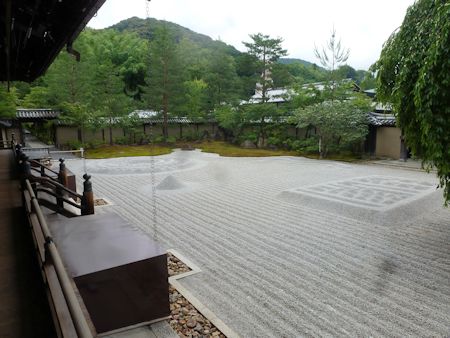 |
|
The garden was redesigned by the renowned landscape architect Kobori Enshu
(1579-1647) from an older garden located on this site.
Famous for its excellent stone layout, it is one of the finest gardens
of its period. In the north section of the pond is an island in the form
of a turtle, and in the south section is a group of stones representing
cranes.
This garden has been designated by the Japanese Government as a "Place
of Historical Importance and Outstanding Scenery." |
|
Such garden as Garden of Cranes and Turtles is called Chisen-Kaiyushiki garden, a style of Japanese garden with a path around a center pond and spring. In this garden Engetsuchi Pond and Garyuchi Pond face each other across Kaizan-do Hall.
Kobori Enshu created the gardens of this style at Nijo Castle as Hachijin-no-niwa
of the Ninomaru Palace Garden, and at Nanzenji Temple as Toranokowatashi-no-niwa
which we visited this March.
And well, the North Garden at Entokuin Temple, too, which we saw a little
while ago.
I found the name of Kobori Enshu in the Internet sites of scenic places
and gardens in Japan.
He does not seem to be only a garden designer. A certain website "Koto-bank"
says like this.
|
Kobori is a master of tea ceremony and a samurai.
He learnt tea ceremony under Furuta Oribe. As the sakuji bugyo (commissioner
of building), he showed off his abilities for the building construction
and the garden creation. The gardens in Nijo Castle and Sendo Palace are
famous.
Besides, he excelled at paintings and calligraphic works as well as waka-poem.
Also he is famous for an appraiser of objets d'art and curios.
Later he became Fushimi Magistrate and died in Shoho 4 (1647) at the age
of 69.
The following is his farewell waka poem.
|
昨日といひ今日とくらしてなすことも
なき身の夢のさむるあけぼの |
- - - - -
Taking the opportunity to stray off the subject, one more side street.
I would like to ascribe this slow work to the jazz sounding from the radio
NHK-FM. I swiched it off and my work got much slower feeling I fell into
the dark.
Now I have decided to listen to classical music on the LP player.
I have more than 500 LPs besides CDs on the shelf.
Lively or noisy music is too much. So, Johann Sebastian Bach came out to
me first. And finally I selected his "Six Suites for Solo Cello BWV
1007-1012" (Archiv, 3 LPs) played by Pierre Fournier.
I am sure I bought it at the record store in the Ministry of Economy, Trade
and Industry near the Tokyo Branch office of our Daido Steel Co. around
40 years ago. The LPs are like a new one which proves I have ever listened
to them only a couple of times.
I put the side A of the 1st LP on the player and the gentle sound begins.
It is far from harsh on my ears, and more than that, it may be helpful
to my work.
Not knowing, 2 hours have passed when the 6th suite ended. It is 4:00 pm.
I have totally forgotten about the travelogue.
However, this album seems to be matched well with the temples and shrines
in Kyoto now proceeding in my work. All of the suites are not assertive,
but rather have a modest sound. They could not interrupt the work.
Listening to them and looking at the pictures taken at Kodaiji Temple,
the chic views of the garden created by Kobori Enshu, Kangetsudo Hall,
Kaizando Hall, ..., all of them seem to be comfortable with this BGM.
Nene's devotion to her life and faith rather than her love to Hideyoshi. In such a world of fantasy, I decided to proceed the travelogue listening to Bach.
|
|
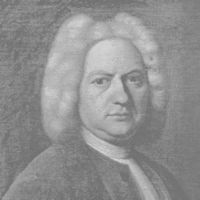 |
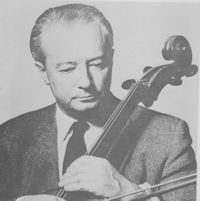 |
| Johann S Bach |
Pierre Fournier |
| from the pamphlet of the LP album. |
- - - - -
Actually the sound of this LP album is echoing during my reading of the
Japanese edition of this travelogue.
Now just before the start of reading this English edition, I happened to
find another MD album of the same music on the same shelf.
It is really Johann S. Bach's Six Suites for Unaccompanied Cello, BWV 1007-1012.
This album is played by Yo-Yo ma.

from the pamphlet of the MD album
So, the BGM during my reading here is this album.
|
| - - - - - - - - - - |
| Chionin Temple |
|
|
From Kodaiji Temple through Yasaka Shrine again to the north for a while,
we were already at Chionin Temple.
On the way we had soba-noodle lunch at a restaurant next to the theater
of Yoshimoto-Shinkigeki. So, there were many colored papers of famous actors
and actresses put on the side walls.
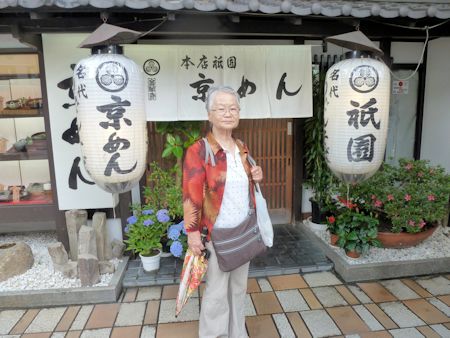
|
|
|
Chionin Temple is a large and very popular temple. Its massive front gate,
the largest of its kind in Japan, is an awesome sight. The grounds are
often full of people who pray in front of the images of the main hall.
You may see people standing in front of a large brazier, holding small
sticks of incense, or waving the fragrant smoke over their heads in an
effort to receive inspiration and wisdom.
The temple also has the largest bell in Japan on its grounds, one that
reputedly weighs more than several city buses. Standing just north of Maruyama
Park and Yasaka Shrine, the temple grounds are free to enter and are a
natural part of any walking tour of Kyoto's Higashiyama District.
The temple began its days as a modest hut occupied by the priest Honen,
founder of the influential Jodo (Pure Land) sect of Buddhism. His teachings
were simple to grasp and attached a large following. Chionin Temple is
now the head temple of the Pure Land Sect of Buddhist movement.
(Kyoto City Official Travel Guide)
|
|
|
|
The San-mon Gate in the picture was built in Genna 5 (1619), which is now
the largest wooden structure in Japan.
Passing through the gate and then going up the steep stone steps called
Otoko-zaka, we entered into the precincts finally.
Chion (知恩) in the Japanese letter means "know a favor". The beginning of this temple is said to be when Genchi, an apprentice of Priest Honen, built the Mieido temple at Honen's house once stood after his master's death. So, the name of the temple is "Mieido Hall" (御影堂, Thinking-of-the-Master Hall), or not?
Mieido Hall was under repair, so we walked on the corridor from the abbot's
chamber there partly. This corridor is one of the Seven Wonders of Chionin
Temple. Truly while we were walking along it, the sounds like the song
of a bush wabler were echoed by each step.
Another one of the Seven Wonders is "Nuke-suzume Folding Screen".
"Nuke-suzume" means that the sparrows drawn in the folding screen
were too good to stay here. So, they flew away.
The rakugo of the same name played by Kokontei Shinsho came out to me,
though the stage and the contents are totally different.
Chionin Temple, Other Pictures
|
| - - - - - - - - - - |
| It was already 4:30 p.m. We walked to Higashiyama Station of Metro Tozai Line. The Station of Kyoto City Office near our hotel was the second stop.
We bought a box of sushi, a canned beer and some others at a convenience
store. The dinner was in the room after shower watching TV.
I went to bed at 7:00 and fell into sleep listening to rakugo in the iPod.
|
|
|
|
|
|
|
|
|
|
|
|
|
|